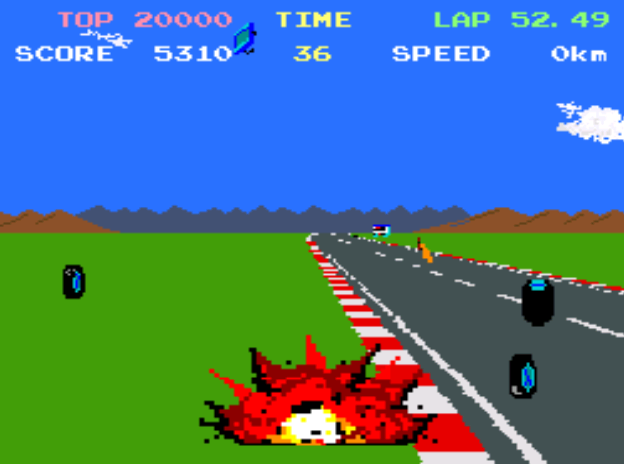
Before iRacing, before Gran Turismo, heck, before OutRun, there was one racing video game that blistered our fingers and drained our quarters faster than all the rest.
And considering it was released to the public September 16th, 1982, we figured now’d be a good time to talk about it.
The game is Pole Position.
While it may look simplistic compared to today’s hyper-realistic driving simulators, Pole Position was a quantum leap in racing games. It drew heavily upon real Formula 1 racing and featured vehicle physics that were about as good as you could get for the era.
Developed by NAMCO (the same folks that gave us Pac-Man and Galaga) and licensed by Atari, many video game historians consider Pole Position one of the best racing games of all time.
From its race cars to its standing start, it’s clear that Pole Position designers modeled the game after Formula 1 racing. And that’s even more evident when you discover that the track is based on the real Fuji International Speedway in Oyama, Japan—the first time a legit race track appeared in a video game, ever.

While the controls are simple, with just a gas pedal, steering wheel, and high/low shifter, you still have a lot to think about to maintain enough speed to win. Steering is intuitive and responsive, but the game’s rapid pace keeps you on your toes. To slow down, you simply let off the gas pedal or downshift. Turns come on fast and the onslaught of the computer-controlled cars never stops. One wrong move sends you off track or, worse yet, into a competitor.
Still though, the game’s perfect balance of fun and difficulty helped these arcade machines devour quarters.

It was also one of the earliest games to incorporate real-deal signage along the race track. While it goes by pretty fast during normal gameplay, you’ll see billboards for easily recognizable brands like Pepsi, Champion Spark Plugs, and Marlboro. That simple feature may not seem like much nowadays but, at the time, it contributed a ton to the game’s overall realism.
You also had to qualify before the official race began, which was a bit of a surprise to folks unfamiliar with how Formula 1 (and similar) racing operates—but again, it was all an effort to replicate a real racing experience.

All this attention to detail gave NAMCO and Atari a winner.
Upon its release, Pole Position was a quick hit in its home country of Japan, before it went on to conquer the arcades in Europe and North America later that year. It soon spawned a sequel, Pole Position II, which was pretty similar and included some more tracks, also inspired by real ones: Suzuka, Indianapolis, and the Long Beach, California circuit used in the 1982 Formula 1 United States Grand Prix West.
And Pole Position raced into living rooms too, being ported to home video game systems like the Atari 2600 and Commodore 64. It was even turned into cartoon, where the episodes served as a precursor to the short-lived CBS Saturday Supercade.

The last thing we’ll mention about Pole Position—and it absolutely needs to be mentioned—is that the Atari 2600 version gave us what is, quite possibly, the best TV commercial ever made.
E-V-E-R.
You could lock Ridley Scott, Steven Spielberg, and Martin Scorsese in a room for 10 years, and they’d still never come close to creating a short film as awesome as this.
Watch and enjoy:
“It’ll bust ‘yer crank, and leave skidmarks on your soul.”
That’s dark, man. But hey, at least the song’s catchy.
Got any memories of this game? Perhaps you’re more of an Enduro fan or have another alternate title to suggest? Let us know in the comments.

Hey. I like such old games, even if graphics is low. In my opinion it is really interesting:)
[…] it might not have the celebrity of an icon like Pole Place, Dragster remains to be a beloved cult basic for a lot of racing online game followers. And who is […]
I like game!